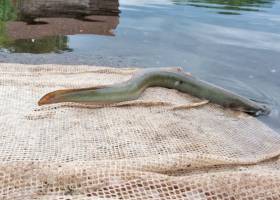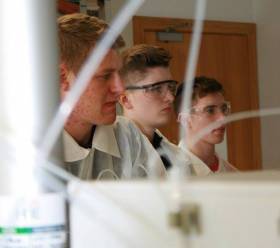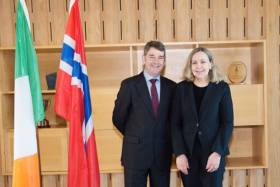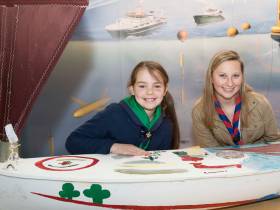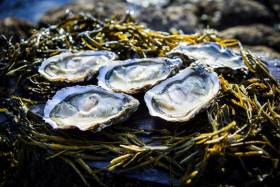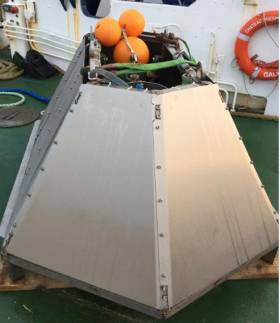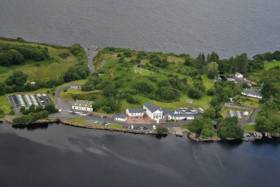Displaying items by tag: marine science
Eel Fishermen Celebrated By IFI For Scientific Contributions
#Fishing - Local eel fishermen were celebrated recently at an information day hosted by Inland Fisheries Ireland in Athlone.
The fishermen, who are involved in IFI’s Scientific Eel Fisheries in different parts of the country, attended the event which aimed to provide an update on the progress made through these fisheries and to recognise the contribution of the fishermen to date.
In total, there are 11 fishermen involved in the initiative, with many experienced in fishing for eels over several years.
Since last year, they have provided support to IFI by fishing for eel in a conservation-focused manner with a view to gathering necessary data which will help protect the species into the future.
Their local expertise and historical knowledge around eels in their areaa has given invaluable support to IFI during the set up and delivery of the Scientific Eel Fishery.
IFI commenced the process of setting up a network of scientific fisheries for eel around Ireland in 2016. These scientific fisheries cover the different life stages — glass eel, elver, yellow and silver eel — and are distributed in key catchments around Ireland.
The purpose of the fisheries is to increase the knowledge around eels in Ireland ahead of the next EU review of this endangered species, and to inform the management of eel populations which are currently in decline.
Dr Cathal Gallagher, head of R&D at IFI, said: “This important partnership between eel fishermen and research has one shared objective: to improve our knowledge of the state of the eel populations and to ensure their conservation for future generations.
“Inland Fisheries Ireland appreciates the benefit of citizen science programmes such as this one which will preserve the heritage of eel fishing and at the same time deliver on the research requirements needed to report to the EU. I would like to recognise and thank all the fishermen involved for their support.”
Citizen science is growing in popularity and encompasses many different ways in which citizens who are non-scientists are involved in scientific research projects.
The involvement of fishermen in the Scientific Eel Fisheries plays an important role in respecting the tradition and heritage of eel fishing in Ireland. Many of the fishermen come from families where eel fishing has been practised across several generations with local expertise and knowledge passed down through the years.
#MarineScience - Over 20 Transition Year students participated in a wide range of activities at the Marine Institute as part of Engineering Week this past week from Monday 27 February to Friday 3 March.
For the third annual TY training week at the Marine Institute headquarters in Oranmore, the fourth-year pupils from Mayo, Galway, Kerry, Cork and Tralee increased their understanding of and interest in marine science, research engineering and technology careers.
Scientists and staff from the State agency responsible for marine research and innovation welcomed the opportunity to share their passion and insights across a wide range of areas in the marine science and maritime sectors.
Ireland's marine sector is a vibrant part of our national economy and the need for education in the marine sector at all levels is highlighted by Ireland's Integrated Marine Plan, Harnessing Our Ocean Wealth, according to Marine Institute chief executive Dr Peter Heffernan.
“Increasing the student's knowledge and engagement with marine careers in science, technology and innovation, as well as the sustainable development and management of our marine resource, is key to support Ireland's ocean economy, where highly qualified and skilled professionals are needed in the coming years,” he added.
The annual TY training course offers students an intensive week of shadowing scientists and staff learning about marine science, technology and engineering as well as a range of diverse supporting disciplines.
Promoting ocean literacy, the students took part in interactive experiments involving IT applications, marine environment and food safety, fisheries sciences, research vessel operations as well as advanced mapping, maritime development and communications.
The students found themselves working with hairdryers, balls and vinegar learning about data collection to how human industrial activities affect the increased levels of carbon dioxide in the ocean.
Interactive activities included dressing up in wet gear, forming sand sculptures of shipwrecks and working on group poster presentations provided learning opportunities that extended their skills and interests as well as raising their awareness about the ocean.
“With the training week fully booked out, we were delighted to see the increased levels of interest and understanding of the marine and the direct benefits of the communications and team building training that form an essential part of this rounded programme,” said Marine Institute HR manager Catherine Quigley-Johnston.
The programme aims to ensure a diverse and well-educated generation of marine scientists and researchers for the future, she added.
“The feedback from students confirms the need for industry and third level institutes, as well as State agencies to promote training and access for young people in marine and maritime careers.
“The training programme also highlights the effort and willingness of the Institute's staff to share their areas of expertise with the younger generations. This is what helps makes TY open days and training weeks so successful,” said Quigley-Johnston.
Marine Institute Hosts Norwegian Ambassador’s Galway Visit
#Research - A recent visit to the Marine Institute by the Norwegian Ambassador to Ireland Else Berit Eikeland was an opportunity to discuss marine research collaborations with a North Atlantic partner.
That’s according to Marine Institute chief executive Dr Peter Heffernan, who added: "The essential role of international cooperation in developing our knowledge of the Atlantic and North Atlantic Ocean and its dynamic systems is necessary, particularly in a time when we need to adapt to climate and environmental changes taking place around the world.
"Aligning our research efforts in areas such as fisheries ecosystem management; marine environment and food safety in aquaculture and shellfish; as well as oceanographic digital research, provides us with future partnerships that can benefit and improve ocean health and stewardship as well as promote the sustainable management of our ocean resources.”
The Marine Institute hosted the visit of Her Excellency Else Berit Eikeland, Ambassador of the Royal Norwegian Embassy to Galway, where she met executive management at its headquarters in Rinville, Oranmore last Thursday 23 February.
Transatlantic Friendship Over Unmanned US Sailboat
#Lancer - An American high school student this week made the trip across the Atlantic to meet the Galway schoolgirl who found her marine science project mini-yacht last year.
Kaitlyn Dow from Waterford High School in Connecticut met eight-year-old Méabh Ní Ghionnáin for the first time at the Marine Institute in Galway for the official handover of the unmanned Lancer sailboat, which is set to be relaunched from the RV Celtic Explorer in the Atlantic later this year.
The 1.5m boat provided by Educational Passages was used as part of Kaitlyn's year-long research project studying wind and currents in the ocean.
Fitted with a GPS transmitter, the boat was released in May 2016 by NOAA ship Neil Armstrong off the coast of Cape Cod and successfully crossed the Atlantic.
In September, Kaitlyn made an appeal to Afloat.ie readers to keep a look-out for Lancer as it was tracked as far as Galway Bay.
And when it was eventually washed up in Connemara on 20 September, Méabh was the first to find it after following its GSP signal to a spot near her home in Lettermore.
Marine Institute chief executive Dr Peter Heffernan congratulated Méabh and Kaitlyn on their endeavours, adding: "We are thrilled to be involved with the continued voyage of the Lancer sailboat where it will be launched from the research vessel RV Celtic Explorer during its up and coming transatlantic expedition in April.
"This story is a wonderful example of both science literacy and citizen engagement with the oceans – themes which are a priority for the Atlantic Ocean Research Alliance between Canada, the EU and USA.
“Seeing new friendships formed across the Atlantic at an early age highlights the value of international partnerships that are essential for sharing marine science.”
Dr Heffernan added: “With the Atlantic being the second largest ocean in the world, it is important to increase our awareness of the value, opportunities and societal benefits the ocean provides us.”
Michael O'Connor, Kaitlyn's science teacher from Waterford High School, also made the trip to Ireland wit her and her family.
"I am thrilled to see this project to the next stage bringing Méabh and Kaitlyn together,” he said. “Although this started as a science project, the social connections and the sea that binds them are just as important as the data collected.
"Kaitlyn learned to design a study from the ground up, figure out how to fund it, make the social and professional connections to further the project and foster an international dialog about the ocean.
“She has a love for sailing and turned that love into a science project with great social impact and a great story. She will carry that combined social service and love of the sea to the Coast Guard Academy next year for college.”
Lancer was repaired by Ciaran Oliver and James Rattigan from Port of Galway Sea Scouts, as previously reported on Afloat.ie.
The Sea Scouts recently visited the RV Celtic Explorer with Méabh and will also be attending a seashore safari with Galway Atlantaquaria and the Explorers Education Programme team later this month.
IFI Stands Up For Women & Girls In Science
#MarineScience – Women at Inland Fisheries Ireland who work across science projects are celebrating International Day of Women and Girls in Science today (11 February 2017).
International Day of Women and Girls in Science is a UN initiative which aims to help achieve full and equal access to and participation in science for women and girls.
Staff working in IFI carry out scientific fisheries research, monitoring and investigations which aim to manage, improve and protect the inland fisheries resource.
Find out more about International Day of Women and Girls in Science here.
NI Scientists Head Whale & Dolphin ‘Listening’ Project
#MarineScience - Scientists from Northern Ireland will lead a new project monitoring whale and dolphin sounds off the Scottish and Irish coasts, as BBC News reports.
The scheme led by the Agri-Food and Biosciences Institute (AFBI) will see a network of buoys deployed with devices to pick up cetacean chatter – as well as potentially harmful ocean sounds from sea traffic or industry.
"Displacement from noise is a very real effect and ... if it doesn't cause them to move will change their behaviours and, at the most acute levels, can cause physical and physiological damage to the animals,” says Dr Adam Mellor of the AFBI.
BBC News has more on the story HERE.
Marine Institute Recruiting Temporary Laboratory Analyst For Foodborne Viruses In Shellfish
#Jobs - The Marine Institute requires a laboratory analyst to provide support to a two-year research project investigating norovirus, hepatitis A virus, hepatitis E virus and sapovirus concentrations in oysters.
The work will primarily involve laboratory based detection of the viruses in oysters using existing and proposed molecular procedures. In addition, there may be some elements of field work including sampling and environmental monitoring.
This temporary specified-purpose contract of employment is funded under the FIRM programme and will run for a duration of up to two years. The successful candidate will be on probation for the first six months.
To apply, a CV and letter of application summarising experience and skill set applicable to the position should be emailed to [email protected] or posted to Human Resources at the Marine Institute, Rinville, Oranmore, Galway. All correspondence for this post should quote reference LA-FIRM-Jan 2017
All applications for this post should be received by the Marine Institute before noon next Tuesday 7 February. Late applications will not be accepted.
A detailed job description is available from the Marine Institute website HERE.
#MarineNotice - The latest Marine Notice from the Department of Transport, Tourism and Sport (DTTAS) advises that University College Dublin is running a scientific wave measurement campaign deploying a bed mounted ADCP at Inis Meáin in the Aran Islands s of yesterday (Saturday 28 January).
The ADCP, or acoustic Doppler current profiler, is deployed in a seabed-mounted frame at a depth of around 40 metres, with a ground line between the frame and a clump weight also rested on the seabed.
The purpose of the deployment is for measurement of waves and currents of the coast of Inis Meáin. This is a temporary deployment and it is proposed that the ADCP will be recovered before 15 May this year.
Co-ordinates and a map showing the deployment location are included in Marine Notice No 2 of 2017, a PDF of which is available to read or download HERE.
Taoiseach Announces €6M Investment & 20 New Jobs At Co Mayo Marine Research Facility
#MarineScience - Taoiseach Enda Kenny today (Saturday 28 January) announced the creation of 20 new jobs and a €6 million investment in the Marine Institute's facility in Newport, Co Mayo.
The 20 new positions will be based at Newport research facility where they will be engaged in a number of projects funded from a secured pot of €6 million in research grants from a number of agencies including the Science Foundation Ireland, Interreg, EU H2020/European Research Council, European Maritime and Fisheries Fund (EMFF) and the British Research Council.
Speaking in Furnace, near Newport, the Taoiseach — who is also TD for Mayo — said the move “is very timely following the launch of Realising our Rural Potential – the Action Plan for Rural Development earlier this week.
“The Newport facility is a real example of innovation taking place in a rural community and creates exciting opportunities both now and in the years ahead.
“Scientists at doctoral and post-doctoral level working at the facility are involved in conducting research with not only national implications, but also international relevance. In other words, it firmly brings what is a rural area into a national and international context.”
The Taoiseach added: “This is a relatively unique research facility in operation since 1955 and I am delighted to see the continued excellent quality research that is taking place following €6 million in funding from research grants.
“I also wish to thank the Marine Institute and their educational partners for their efforts in building a strong international reputation for marine research and innovation."
The Marine Institute says a range of cutting edge research is carried out at its Newport facility including genetics work across several species of salmon, sea bass and pollock, research on the catchment, and climate change.
The facility is attracting multiple Irish Higher Education Institutions and international partners including University College Cork, Queens University, University College Dublin, GMIT, Dundalk Institute of Technology, NUI Galway and the University of Glasgow.
In addition, the Marine Institute is working with Mayo County Council to actively develop new initiatives at the facility to further enhance what the Marine Institute can offer and benefit the local area.
Supporting the announcement, Marine Minister Michael Creed said that his department and the fishing industry consider pollock “a very important commercial species for some elements of the Irish fleet. It is good to see a new project on this species being carried out in Newport, using the scientific expertise that is there."
Marine Institute chief executive Dr Peter Heffernan added: "Ireland has been gaining a reputation in Europe, and internationally for its marine research and innovation, and for driving collaboration in this area. We have a strong marine research community supported by growing national research infrastructure.
“This €6 million investment programme will see the Marine Institute expand its research capacity at its Newport facility and the continued investment in marine research will ensure that Ireland stays at the cutting edge of research and innovation."
In his own welcoming statement, Mayo county manager Peter Hynes said: "This is fantastic news for Mayo and the West region and Mayo County Council looks forward to continuing to work with the Marine Institute to further develop this cutting edge research facility here in Newport."
#MarineScience - The Marine Institute is inviting students to apply for a number of work placement bursaries in many exciting areas for the summer of 2017.
The Marine Institute Bursary Scholarship Scheme is worth €275 per week for an eight- to 12-week placement, bursary dependant. Placements will be based in various locations including the Marine Institute at Oranmore, Co Galway; Newport, Co Mayo; and other locations and ports around the country.
The Marine Institute's Bursary Scholarship Scheme provides valuable practical experience for marine science students in areas of research such as marine fisheries, salmon management, aquaculture, the Fish Health Unit, oceanography instrumentation, benthic ecology, communications and R&D.
Last summer’s programme saw 28 students from across Ireland embark on work placements in a variety of areas including salmon and shellfish assessments, fish sampling at ports, maritime economics and even app development.
The programme is aimed at undergraduates of universities, institutes of technology and national institutes for higher education. The scheme is strictly limited to undergraduates who will have completed two years study in a relevant discipline by the beginning of June.
Previous bursars have gone on to work in the Marine Institute (including two directors of the institute), BIM, Regional Fisheries Boards, county councils, pharmaceutical companies and State laboratories, with some going as far afield as the EPA in Sydney, Australia, and others now running their own companies.
To apply for the Summer Bursary Programme, check out the bursary titles on offer, and select the two bursaries that interest you most in order of preference. Then complete the application form and return it FAO Annette Jordan, Marine Institute, Furnace, Newport, Co Mayo by the deadline of Friday 10 February.


























